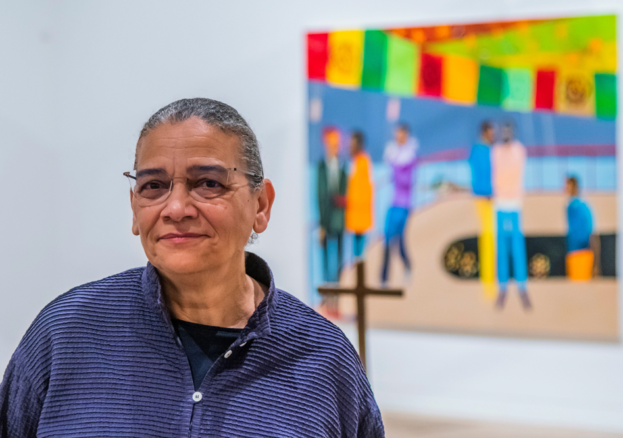
Lubaina Himid is a name that resonates powerfully in the world of contemporary art. As a pioneering figure in the British Black Arts Movement and the oldest artist to win the prestigious Turner Prize in 2017, Himid’s work is celebrated for its vibrant, thought-provoking exploration of race, identity, and history. Her career, spanning over four decades, has been marked by a relentless commitment to breaking barriers and challenging the status quo.
Lubaina Himid was born in Zanzibar, Tanzania, in 1954. Her early life was marked by a rich cultural heritage, which would later deeply influence her artistic practice. After her father’s untimely death, she moved to the United Kingdom with her mother, who was a textile designer. Growing up in the UK, Himid was acutely aware of her dual heritage and the complexities of navigating different cultural identities.
Himid studied Theatre Design at Wimbledon College of Art, graduating in 1976, and later earned an MA in Cultural History from the Royal College of Art in London. Her background in theatre design is evident in her work, which often incorporates elements of stagecraft and narrative storytelling.
The British Black Arts Movement
In the 1980s, Himid became a leading figure in the British Black Arts Movement, a radical and politically charged movement that sought to address the underrepresentation and misrepresentation of Black artists in the UK. This movement was instrumental in giving voice to Black artists and challenging the art establishment’s exclusionary practices.
Himid’s early work during this period was characterised by its bold use of colour and its focus on the African diaspora’s cultural heritage and experiences. She curated significant exhibitions such as “Five Black Women” at the Africa Centre in London (1983) and “The Thin Black Line” at the Institute of Contemporary Arts (ICA) in London (1985), which showcased the work of Black female artists and challenged the dominant narratives in contemporary art.
Themes and Techniques
Himid’s work is distinguished by its vibrant colours, intricate patterns, and narrative depth. She often employs historical references and recontextualises them to comment on contemporary social and political issues. Her pieces frequently explore themes of race, gender, and the legacies of colonialism, inviting viewers to reconsider history from the perspective of the marginalised.
One of her most notable series, “A Fashionable Marriage” (1986), draws inspiration from William Hogarth’s satirical paintings to critique the complicity of British society in the slave trade. This piece, like much of Himid’s work, uses wit and irony to engage viewers and provoke critical reflection.
Himid also utilises a variety of mediums, including painting, installation, and printmaking. Her installations often transform gallery spaces into immersive environments that challenge traditional art viewing experiences. For example, her installation “Naming the Money” (2004) features 100 life-sized cut-out figures representing enslaved Africans who were brought to Europe. Each figure is accompanied by a narrative, reclaiming their identities and histories from the anonymity imposed by slavery.
The Turner Prize and Later Work
In 2017, Lubaina Himid made history as the first Black woman and the oldest artist to win the Turner Prize, one of the most prestigious awards in contemporary art. This recognition was not only a personal triumph but also a significant milestone for Black artists and older artists, challenging the art world’s often narrow definitions of who can be celebrated and when.
Himid’s winning exhibition included works such as “Naming the Money” and “Le Rodeur: The Exchange” (2016), which explores themes of migration and the human cost of the transatlantic slave trade. The Turner Prize jury praised her for “expanding the possibilities of painting” and her “rigorous and challenging” approach to addressing social issues.
Breaking Barriers and Legacy
Lubaina Himid’s career is a testament to the power of art to break barriers and challenge societal norms. She has consistently used her platform to highlight the contributions and experiences of Black individuals, particularly women, who have been overlooked by mainstream narratives. Her work not only enriches contemporary art with diverse perspectives but also inspires future generations of artists to explore and assert their identities.
Himid’s influence extends beyond her own artwork. As a professor of Contemporary Art at the University of Central Lancashire, she has mentored numerous young artists, encouraging them to find their voices and challenge the status quo. Her dedication to education and advocacy continues to shape the landscape of contemporary art.
Recent Works and Continuing Impact
In recent years, Himid has continued to produce thought-provoking work that addresses pressing social and political issues. Her 2020 exhibition “Blue Grid Test” at the New Museum in New York explored themes of migration, colonialism, and the environment through a series of paintings and installations. This exhibition further demonstrated her ability to blend historical narratives with contemporary concerns, creating work that is both timely and timeless.
Himid’s commitment to addressing global issues through her art underscores the relevance and urgency of her practice. By highlighting the interconnectedness of history, identity, and politics, she invites viewers to engage in a deeper dialogue about our collective past and future.
Lubaina Himid is a trailblazer in the world of contemporary art, whose work continues to challenge, inspire, and provoke. Her vibrant, narrative-rich pieces offer a powerful commentary on race, identity, and history, breaking barriers and expanding the horizons of what art can achieve. As an artist, educator, and advocate, Himid’s legacy is one of resilience, creativity, and unwavering commitment to social justice.
For those looking to explore Himid’s impact further, her exhibitions and publications provide a comprehensive view of her journey and contributions to contemporary art. Through her work, Lubaina Himid continues to transform the art world, ensuring that diverse voices and histories are not only heard but celebrated.
